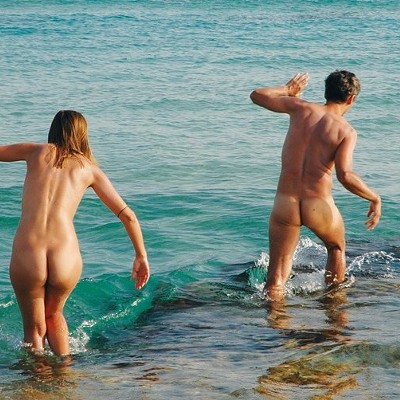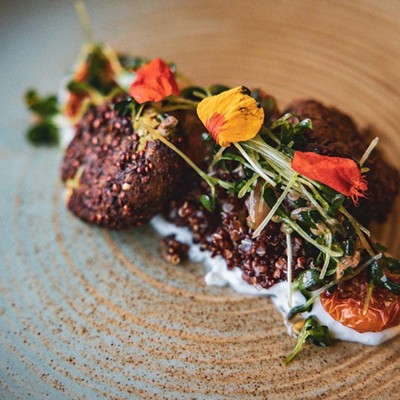
Theriault tells The Coast that Feed NS's 141 member organizations began to adapt to new ways of providing for their communities.
“Many of them are doing different things than they usually have done,” she explains. “Whether it’s a different process in the way that they’re handing out food, or taking on an additional role to distribute food.”
Of those 141, 85 members are food banks, while the other member agencies range from community groups that provide hot breakfast and after-school care, to shelters like Adsum House and Bryony House. The organizations are different but Theriault says they all “have food support as part of their mandate.”
As some groups adapted, others were forced to close throughout the pandemic.
“A couple of food banks that either, their physical facility was too small or the volunteers themselves were all perhaps elderly or had some immune considerations themselves, so they had to temporarily shut down and we support their decisions as well,” says Theriault.
But for those that have stayed open, their new services include everything from parking-lot pickup to home delivery.
“Easily 90 percent of the food banks continue to be open and they have found ways to safely provide food support while respecting all of the public health physical distancing requirements and such,” Theriault says. “So some of them changed from having people come in the waiting area to get their food, or to get the food placed in the trunks of their vehicles in the parking lots.”
Feed Nova Scotia’s headquarters—which provides food and sometimes financial aid to the member organizations—also jumped into action when the pandemic began, spending $800,000 on non-perishables. “We actually distributed 30 percent more food in the first seven weeks of the pandemic than we did the same time the year previous,” says Theriault.
Instead of asking the public for donated food (to avoid disease transmission), they asked for charitable donations. And Nova Scotians heard them loud and clear.
“This is usually our quiet time for financial donations, and I’d put it more on par with what the typical pre-Christmas season of generosity has been. People really just thinking about their friends and neighbours,” Theriault says.
The director of development says fundraisers online have ranged from local breweries donating a portion of profits, to apparel companies selling t-shirts, and even “toilet paper earrings.”
“I shouldn’t be terribly surprised by that, Nova Scotia is a province that has continually shown that we take care of each other,” she says.
But the group has also faced challenges, having to find new ways to work with 15 short-term staff in their warehouse instead of shifts of volunteers.
“We thought, we cannot have a rotating door with 150 different people a week,” says Theriault.
Those employees are helping pack what will be 20,000 boxes of food to be delivered across the province as part of Feed Nova Scotia’s newest initiative, the COVID-19 food box program. It started Monday, May 25.
“Usually through our food banks and other meals programs, we love to provide fresh and frozen products as well, but we aren’t able to ensure the food cold chain integrity here,” Theriault says. “So it is just non-perishables, and it’s about a $35 value per box.”
The new program is intended for people who can’t get out of their house or access other food programs during COVID-19.
“We have heard from some people that they used to go to the food bank in their neighbour’s car, or a few of them would carpool together and go to the food banks. Well now, they weren’t able to travel together if they weren’t in the same household,” says Theriault.
Others have medical concerns or need to self-isolate, and those with (understandable) anxiety about taking public transit may not have another way to get around. “They have said, ‘I’d rather be hungry than leave my home to get food,’” says Theriault.
“So that’s where the idea for this COVID-19 food box program really came from, saying that we need to have more of the ability to provide that home delivery service.”
In the first three days of the program, Feed NS has delivered to 59 households. In Halifax and Cape Breton, it’s being done by volunteers. In other parts of the province, it’s done by courier. “They use all the proper PPE, so masks and gloves, especially if they are interacting with anyone from the community,” says Theriault.
As part of the food box program, an individual receives two boxes, and two or more people can receive four boxes. Theriault says the boxes can take anywhere from one to five days to be delivered, so they aren’t for people with immediate food needs.
“If someone is in an emergency situation and needs food right this moment, but it’s going to take five days to get food to them, clearly they need to work to find another option,” she says.
Although Feed Nova Scotia isn’t sure how long the program will last, Theriault says it’s another way to be able to address food insecurity.
“This is one extra option I guess being added to a very big toolbox. When you look around the province, so many community groups are doing amazing stuff to make sure that people have food, and now this is one other option out there,” she says.
Theriault also says that food insecurity has also been in the spotlight recently, with everything from flour to cans of beans flying out of stock on grocery store shelves.
“All of a sudden even if you thought I never would be vulnerable to not having access to food, but to have that fear of oh my goodness, I can’t buy what I need to buy,” she says. “So, imagine if that is your everyday reality.”
Although it’s unfortunate it’s due to the ongoing pandemic, Theriault is glad that food access is on the public’s mind.
“Nova Scotia has the highest rate of food insecurity of all the provinces across Canada, and it just feels like this crisis has brought that more to light for people,” she says. “And I hope that we can build on that to make sure that once the immediate crisis of this pandemic is over that people remember what that felt like, and push for big change.”
If you think the COVID-19 food box program is right for you, you can call 211 between 8am and 8pm on weekdays. To find other food banks or programs in your community, you can use Feed Nova Scotia’s online find food tool.















